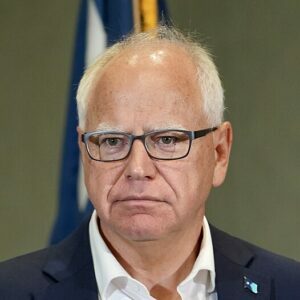While Democrats tout Minnesota Gov. Tim Walz’ “rural appeal” as Vice President Harris’ running mate, rural health providers in his state are grappling with higher costs and cumbersome burdens he signed into law.
At issue is the 340B Drug Pricing Program which provides financial help to hospitals serving vulnerable communities, many of them in rural areas like northern Minnesota.
Section 340B of the Public Health Service Act requires pharmaceutical manufacturers participating in Medicaid to sell outpatient drugs at discounted prices to healthcare organizations that care for many uninsured and low-income patients
In May 2023, Walz signed legislation adding paperwork requirements to hospitals and clinics participating in the 340B program, in certain reports on their total drug acquisition costs and payments.
Walz made Minnesota the first state to require rural providers to account for those costs as well as breaking down the information by payer type, such as whether patients used traditional insurance or Medicaid.
Additionally, as America’s Essential Hospitals– a trade association many of whose members participate in the 340B program--noted after Walz signed into law the requirements, “the law requires 340B hospitals to report these data points at the national drug code level for the 50 most frequently dispensed drugs. Other covered entity types are not bound by this requirement.”
Advocates for rural healthcare providers say targeting the 340B for additional paperwork puts pressure on facilities that are already struggling to pay the bills or hire enough workers. Every new dollar or labor hour added by the Walz legislation is one that is lost from its core mission of providing care to marginalized communities.
The new reporting requirements, which began April 1, were supported by large pharmaceutical companies and, critics say, buried in an omnibus healthcare bill from last year. Small, local healthcare providers were caught by surprise by the new requirements.
Separate legislation Walz signed in May required 340B providers to report program administration payments and payments made to non-pharmacy entities as well as levying $500 daily fines on covered entities that do not comply with the new data requirements.
Advocates for the 340B program say major pharmaceutical companies want to kill it, and they fear this new law is part of the ongoing effort by drug manufacturers and others to restrict the program.
Air340B, “The Alliance for Integrity and Reform” is funded in part by the Pharmaceutical Research and Manufacturers of America – PhRMA — and is an outspoken critic of the program. It claims, “The 340B program has veered off course from its intended purpose,” calling it a cash cow for hospitals, not all of which the drug industry regards as needy.
But major U.S. healthcare stakeholders support the 340B program.
Groups like the American Hospital Association, the Catholic Health Association of the United States, and the Children’s Hospital Association released a joint statement defending the program and urging Congress not to add restrictions. They argue some patients have health conditions which have advanced to the point of requiring the “specialized, complex care only hospitals can provide” at this time.
A report on The Minnesota Reformer looked at how the program operates in various states. In Iowa, Eric Briesemeister, chief executive officer of Jones Regional Medical Center, a rural hospital, said 340B “can be used for tremendous good.” The organization uses the profits it receives through the program to subsidize emergency services as well as programs for uninsured and underinsured patients.
The Reformer article notes that program usage “skyrocketed” in 2010 after passage of the Affordable Care Act that let rural hospitals and clinics contract with an unlimited number of retail pharmacies. The Drug Channels Institute reported purchases of medications under the 340B program hit $53.7 billion in 2022 compared to approximately $44 billion the year before. It has also become the second largest drug program after Medicare Part D.
A 2019 survey from 340B Health, the leading advocate for providers participating in the program, found providers are using the money they save and profits they receive through the program in other ways to benefit low-income patients, such as expanding emergency services. The study found the median 340B benefit ranged from $564,000 for Critical Access Hospitals to $12.6 million for Children’s Hospitals. Disproportionate share hospitals, which are traditionally the largest facilities, had a median benefit of $8.9 million.
Critical Access Hospitals are defined as having 25 beds or fewer and located more than 35 miles from another hospital; 340B Health found that 76 percent of them “rely on 340B savings to keep their doors open.”
A separate study published in Health Affairs found 340B was helpful for ensuring the provision of oncology services in rural areas.
In November 2023, the Minnesota Hospital Association released an analysis showing that rural providers were getting slammed from a combination of higher costs for goods and labor, inflation, and falling revenues.
“Workforce shortages, cuts in the federal 340B Drug Pricing Program, persistent delays in discharging patients to step-down care, and a crisis in behavioral and mental health care are adding to the grave financial challenges hospitals and health systems are facing,” MHA President and CEO Rahul Koranne said at the time.


